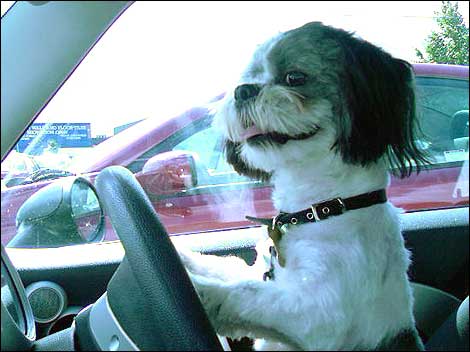Heat stroke
Heat stroke is also known as hyperthermia and it is a common occurrence in animals. There are many animals who are at a higher risk. It is more common in the early summer before acclimation occurs. It is often fatal and can be easily prevented. Animals regulate their body temperature through panting as they have very few sweat glands. As the animal pants, the air evaporates the moisture off the tongue resulting in a "cooling" effect. This mechanism is often impaired due to the animal's genetic make-up or health status. This is not a very efficient cooling system.
Risk Factors include:
- vigorous exercise or increased physical activity,
- overweight animals,
- dark-colored animals,
- heavy-coated animals,
- brachycephalic (short-faced) breeds,
- animals on medication and animals with systemic illnesses (asthma, heart disease, lung disease).
- Brachycephalic animals (Boxers, Pugs, Pekingese, Himalayans, Persians, Bulldogs) have a "flat face" and this anatomic difference results in several respiratory impairments. The nostrils have narrow openings, the trachea (windpipe) is smaller in diameter than normal, and/or the soft palate is elongated.
All these conditions restrict airflow and increase the difficulty in breathing and panting, therefore putting these animals at a higher risk. Many medications have side effects that can cause respiratory depression. If your animal is on medication, discuss the side effects with your veterinarian and make sure your animal companion is not at a greater risk.
 Animals that have heat stroke display signs of excessive panting, hypersalivation, collapse or the inability to rise, vomiting, diarrhea, and seizures or tremors. Many animals are found in enclosed areas such as vehicles or clothes dryers. NEVER leave your pet unattended in a vehicle. "Cracking the window" does not make it okay to leave your animal alone in a vehicle. The animal will pant and "heat up" it's environment, and this will only take a few minutes. If your animal is housed outdoors or kept out for long periods of time, make sure they have access to PLENTY of water at all times. Remember, water evaporates rapidly and animals can knock over the bowls or the water can become contaminated, so it is important to provide at least two different water containers at all times. In the summer months, especially in the Las Vegas valley, it is recommended that you at least double the amount of water available to your animal. Animals that have heat stroke display signs of excessive panting, hypersalivation, collapse or the inability to rise, vomiting, diarrhea, and seizures or tremors. Many animals are found in enclosed areas such as vehicles or clothes dryers. NEVER leave your pet unattended in a vehicle. "Cracking the window" does not make it okay to leave your animal alone in a vehicle. The animal will pant and "heat up" it's environment, and this will only take a few minutes. If your animal is housed outdoors or kept out for long periods of time, make sure they have access to PLENTY of water at all times. Remember, water evaporates rapidly and animals can knock over the bowls or the water can become contaminated, so it is important to provide at least two different water containers at all times. In the summer months, especially in the Las Vegas valley, it is recommended that you at least double the amount of water available to your animal.
Another thing to consider: animals love being around us, but it is not always in their best interest. Taking animals on a long hike or other outdoor activities during the middle of the day or times of excessive heat is not good for them. Many of us enjoy sitting in the sun or doing physical activities in the heat. Do your animal companion a favor and leave them in the air-conditioning or a climate-controlled area so that they remain safe. Most of us wouldn't want to be in the heat with a fur coat on, and neither do they.
Assessing your animal for signs of heat stroke is important as this condition is often quick and fatal. An elevated rectal temperature of greater than 104 degrees Fahrenheit may be an indication that your animal is suffering from heat stroke-related hyperthermia. This is an emergency condition. Immediately remove the animal from the source of heat, spray them with cool water and transport them safely to the nearest veterinarian. Don't take the time to call your veterinarian, just GO!!!!!!!!!!!! Do not induce rapid cooling or use ice or ice water. Extremely cold water causes vasoconstriction (blood vessels constrict) which leads to heat retention. This is the body's natural defense to the cold so that animals and people will stay warm. It is important to lower the body temperature gradually.
|





